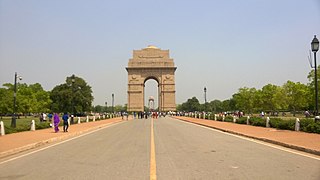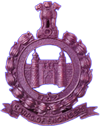
Rajpath, officially named Kartavya Path, and formerly known as Kingsway, is a ceremonial boulevard in New Delhi, India, that runs from Rashtrapati Bhavan on Raisina Hill through Vijay Chowk and India Gate, National War Memorial to National Stadium, Delhi. The avenue is lined on both sides by huge lawns, canals and rows of trees. Considered to be one of the most important roads in India, it is where the annual Republic Day parade takes place on 26 January. Janpath crosses the road. Rajpath runs in east-west direction. Roads from Connaught Place, the financial centre of Delhi, run into Rajpath from north. It was made during the Construction of New Delhi.

Beating Retreat is a military ceremony dating to 17th-century England and was first used to recall nearby patrolling units to their castle.

The Mechanised Infantry Regiment is an infantry regiment of the Indian Army, comprising 27 battalions dispersed under various armoured formations throughout India. Together with the 23 battalions of Brigade of the Guards, they form part of the Mechanised Infantry arm, which along with the Armoured Corps form the Mechanised Forces.

Raisina Hill, often used as a metonym for the seat of the Government of India, is an area of New Delhi, housing India's most important government buildings, including Rashtrapati Bhavan, the official residence of the President of India on a citadel and the Secretariat building, housing the Prime Minister's Office and several other important ministries. The hill is seen as an Indian acropolis with Rashtrapati Bhavan as the Parthenon.

Republic Day is a national holiday in India commemorating the adoption of the Constitution of India, and the country's transition to a republic which came into effect on 26 January 1950.

The Madras Regiment is the oldest infantry regiment of the Indian Army, originating in the 1750s as a unit of the British East India Company. The regiment took part in numerous campaigns with the British Indian Army and the post-independence Indian Army. The Madras Regiment primarily recruits from the erstwhile Madras state and the kingdom of Mysore. However, the 9th and 16th battalions were later formed from troops from the kingdoms of Travancore and Cochin in present day Kerala.
Corps of Military Police (CMP) is the military police of the Indian Army. In addition, the CMP is trained to handle prisoners of war and to regulate traffic, as well as to handle basic telecommunication equipment such as telephone exchanges. They can be identified by their red berets, white lanyards and belts, and they also wear a black brassard with the letters MP imprinted in red.

The Indian Army Corps of Engineers is a combat support arm which provides combat engineering support, develops infrastructure for armed forces and other defence organisations and maintains connectivity along the borders, besides helping the civil authorities during natural disasters. College of Military Engineering, Pune (CME) is the premier technical and tactical training institution of the Indian Army Corps of Engineers.

The Bengal Engineer Group (BEG) is a military engineering regiment in the Corps of Engineers of the Indian Army. The unit was originally part of the Bengal Army of the East India Company's Bengal Presidency, and subsequently part of the British Indian Army during the British Raj. The Bengal Sappers are stationed at Roorkee Cantonment in Roorkee, Uttarakhand.

Madras Engineer Group (MEG), informally known as the Madras Sappers, is an engineer group of the Corps of Engineers of the Indian Army. The Madras Sappers draw their origin from the erstwhile Madras Presidency army of the British Raj. This regiment has its HQ in Bengaluru. The Madras Sappers are the oldest of the three groups of the Corps of Engineers.

The Delhi Republic Day parade is the largest and most important of the parades marking the Republic Day celebrations in India. The parade takes place every year on 26 January at Kartavya Path, New Delhi. It is the main attraction of India's Republic Day celebrations, which last for three days. The first parade was held in 1950, and it has been held every year since. The cultural pageant is a symbol of a diverse but united India.
First Lady of India or First Gentleman of India is the title given to the host of the Rashtrapati Bhavan, usually the spouse of the president of India. There are no official roles or duties assigned to the spouse. The spouse generally attends official ceremonies and functions.

The Tri-Services Guard of Honour is an ad hoc infantry company of the Indian Armed Forces which is responsible for providing guards of honour for high ranking Indian and foreign officials. The company was created shortly after India gained its independence from the United Kingdom in 1947. It is headquartered in New Delhi and is composed of 100 men and women who are drawn from the three services of the Indian Armed Forces. The guard excludes the Indian Coast Guard in any of its protocol events.

The Indian military bands consists of musicians from the Indian Army, Navy and Air Force. Indian military bands regularly participate in international festivals and take part in celebrations dedicated to various national events. These bands are permanent participants in the Delhi Republic Day parade on the Kartavya Path. Today, the Indian Armed Forces have more than 50 military brass bands and 400 pipe bands and corps of drums. A Tri-Services Band refers to a joint Indian Armed Forces military band that performs together as a unit. At the Spasskaya Tower Military Music Festival and Tattoo in Moscow, the band consisted of 7 officers and 55 musicians. The Military Music Wing of the Army Education Corps is the principal educational institution of the armed forces that provides instruction to musicians of all ranks. Instruction is also provided by the Military Music Training Center and the Indian Navy School of Music.

The Indian Navy Band, also known as Indian Naval Symphonic Band is the Indian Navy's full time music band. It was established in 1945 and is currently attached to the INS Kunjali. At the time of it commissioning, it had a strength of 50 musicians. All band members have a bachelor's degree from recognized university and can play competently in at least one military sponsored instrument.
The Madras Regiment Band (MRC Band) is an Indian Army regimental band. It is an active duty band that serves as part of the Madras Regimental Centre in Wellington. It also serves as the de facto unit band of the Defence Services Staff College in the city. The MRC band is regarded as one of the best military bands in the Indian Army. The band consists of the following small ensembles: Symphony Band, Brass Band, and Percussion Section. The 27th Battalion also maintains its own Pipe Band. Outside the conventional musical ensembles of the military, a Chenda Melam team is also on hand.

The Bombay Sappers Regimental Centre Military Band is a regimental military band in the Indian Armed Forces. It is one of the oldest Indian military bands in the country and is one of many Indian Army brass bands. The 30-member band is based at the BEG Centre in Kirkee. The band has a lineage that dates back two centuries and includes it being formerly known as the "Sikh Pioneers Brass Band" under the 3rd Sikh Pioneers. The modern band was founded in 1932 in Sialkot as its current name. A jazz band was established in 1993.

The Indian Army Chief's Band is the Indian Army's full-time music band. It was founded in 1990 as the official band of the Indian Army and the foremost in the armed forces. It also, as its name implies, represents the Chief of the Army Staff at events involving the COAS's presence. The band represents India in most important state events held in the Indian capital. It was raised in 1990 with bandsmen being drawn multiple Indian military bands in order to "retain the true representation of the entire nation in one band". In April 2011, a string section was added, consisting of cellos, violas and violins, elevating it to a symphony orchestra comprising 72 musicians. Outside of the Indian Army, it has also represented the Indian nation at various military music festivals in France, Italy, Sweden, Germany, Great Britain, Russia and Bangladesh.

The Indian Air Force Band, known officially as No. 1 Air Force Band is a full-time military band of the Indian Air Force. It is considered to be the primary musical unit of the IAF, currently stationed in Jalahalli. Outside the symphony orchestra, other military ensembles have included the following: parade band, jazz ensemble, and vocalist group. It falls under the command of the Directorate of Organisation of the IAF.

The President's Colour Award is the highest honour that can be bestowed upon any military unit of India. It is also known as Nishaan, which is an emblem that is worn by all unit officers on the left-hand sleeve of their uniform.

















